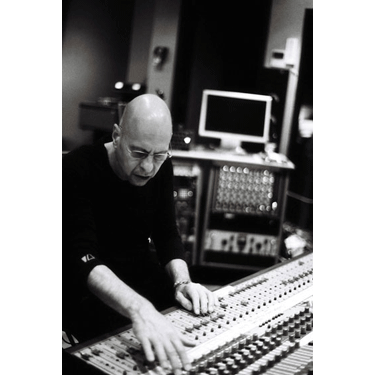|
 Gareth Jones at work at London’s SNAP! Studios. (PHOTO CREDIT: © 2011 Paul Dixon) Gareth Jones at work at London’s SNAP! Studios. (PHOTO CREDIT: © 2011 Paul Dixon)
LONDON, ENGLAND: Gareth Jones is well known for producing ground-breaking albums with ground-breaking artists, such as Depeche Mode, Wire, and Erasure, and he continues to work with their next generation heirs, such as Interpol, Grizzly Bear, and Mogwai. From the start, Jones has been a technological pioneer, blazing trails down which the masses later followed. Jones was an early adopter of digital recording technologies and is today considered one of the world’s foremost experts on the Logic Audio recording, mixing, and editing platform. Relatively recently in the context of his long career, Jones outfitted his studio – which is by necessity mobile – with a pair of Metric Halo FireWire interfaces, that provide him with sixteen studio-grade mic preamps, sixteen channels of AD and DA, powerful DSP processing, 80-bit master summing, and – taken together – the flexibility to do what needs to be done, whatever the circumstance.
Jones started out with just one Metric Halo ULN-8 interface, the manufacturer’s fully-featured flagship product, and quickly added a second LIO-8 with eight optional mic preamps. “With eight preamps, my LIO-8 is no different than a ULN-8, and a bit cheaper,” he laughed. “I quickly discovered that the Metric Halo technology fits beautifully with my workflow. It sounds fantastic. The DSP capabilities and MIO Console’s routing are useful in a hundred different ways – and it travels very conveniently.” These days, for budgetary reasons and, perhaps more importantly, to get a vibe that produces an organic, musical album, Jones often creates “pop-up” studios in his clients’ practice spaces or, more comfortably, in their homes. “When everyone feels comfortable, the music flows,” he said. And with sixteen channels of pure Metric Halo preamps and conversion, Jones can comfortably track a band anywhere.
Recently, Jones did exactly that with a new album for “Emmy the Great.” Her sophomore release, Virtue, benefited from Jones’ perspective and his Metric Halo interfaces. After three days in Red Bull Studio in London, they tracked the remainder of the album at a house in the country using the Metric Halo preamps and converters, and Jones later mixed it using the Metric Halo MIO Console to provide deep, 80-bit summing. “I love the MIO Console,” Jones enthused. “It gives me a bigger, wider, deeper sound than I get with any other in-the-box alternatives. In addition, the Metric Halo DSP provides stunning saturation models that can really elevate a track or an entire mix. And it is recall-able with the ConsoleConnect plug-in.”
Recent work with musician and director Johnny Daukes typifies Jones in a “stripped-down” mode. “The music is very minimal. There is little more than acoustic guitar, a little electric guitar, vocals, and cello, very personal and intimate songs,” said Jones. “I treated it as an eight-track concept and ran my laptop and the ULN-8 at 192 kHz. It’s data intensive, but storage is cheap, and I am enjoying the track and CPU limitation.” In the future, Jones anticipates getting a Metric Halo ULN-2, the two-channel version of the ULN-8, to inspire an even greater “stripped-down” mode when the music would benefit from it or the circumstances demand it. “In fact I have a use for ALL their interfaces”
Depending on the project and logistics, Jones also uses his Thermionic Culture Fat Bustard summing amp and is currently mixing on a vintage Neve console at SNAP! Studios in London. Either way, the Metric Halo interfaces are an integral part of his workflow. “The Metric Halo converters are famously super transparent and thus perfect for sending things out of the computer and for bringing them back in,” Jones said. “At SNAP! I record the output of the console (the mixes are generated at 48k in Pro Tools/Prism interfaces) and all my stems at 96k on my Metric Halos. Wonderful. “In addition, I frequently use the Metric Halo saturation models even when I’m doing things outside of the box. I have a lot of flexibility!” Jones’ Metric Halo interfaces have also played multifarious roles in his recent work with David’s Lyre, Sons and Daughters, Wild Palms, Big Deal and Bunny Lake.
“Apart from the sonics and flexibility, which are really what matter – I know,” Jones laughed, “the Metric Halo boxes look really cool. They always get a positive comment, and anyone into gear has a very hard time resisting the allure of the knobs and the excellent displays. One of my engineers, Neil Quinlan, loved the Metric Halo sound and philosophy so much that he saved up his hard-earned pounds to get a ULN-2. What Metric Halo is doing is not simply a different version of everyone else’s interface topology. It’s a really sophisticated and entirely different thing because of the DSP, the MIO console, and the plugin that recalls the Console. The sound is gorgeous too. For me, they really are the best.”
For more information go to www.garethjones.com. |